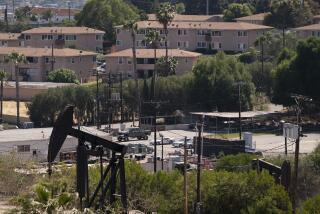Horizontal Drilling Method Could Wring Lots of Oil Out of Old Fields
- Share via
HOUSTON — U.S. oil companies seeking to squeeze more oil out of fields once thought to be depleted are beginning to turn to horizontal drilling, a technology that has the potential to boost output significantly, industry experts said.
Oryx Energy Co. announced this week that it will horizontally drill up to 85 wells in South Texas, and Burlington Resource Inc.’s Meridian Oil Co. has made a similar move in North Dakota.
The announcements “are the first two significant payoffs for horizontal drilling in the U.S.,” said analyst Paul Leibman of Petrie Parkman & Co.
‘Very Significant’
The Oryx development “is very significant because they are looking at producing substantial quantities of oil from an area that many people had written off” as depleted, Leibman said.
Horizontal drilling exposes more of the oil-bearing formation to the well hole, which increases the amount of oil that can be recovered, Ron Turner, an engineer for the oil service firm of Baker Hughes Inc., explained. Typically, only a portion of the oil in a reservoir can be tapped by conventional vertical drilling.
The technology for horizontal drilling has been available for some time but seldom used because of operational problems and high costs.
Turner said Baker Hughes believes horizontal drilling will become much more common in the years ahead. Costs have fallen, although they are still about 50% higher than vertical drilling, and drillers have learned to deal with some of the problems associated with the technique.
Oryx said that horizontal drilling in the Austin Chalk formation has increased production dramatically--in the case of one well from an estimated 37 barrels per day to 1,300 barrels per day.
Longtime Producer
The Austin Chalk, which is a heavily fractured limestone formation that has produced oil for decades in a narrow strip that runs across Texas from the Rio Grande all the way to Louisiana, was a center for the oil boom of the early 1980s, when thousands of wells were drilled.
Activity in the area fell dramatically when oil prices collapsed in the mid-1980s, making it economically unfeasible to produce from the formation.
Oryx said it has leased more than 100,000 acres in the Texas field and plans to drill 20 exploratory wells and 60 development wells by the end of 1990.
In a report issued last week, Petrie Parkman estimated that Oryx may recover as much as 100 million barrels of oil through horizontal drilling. The company’s current reserves total 1 billion barrels.
The other significant horizontal drilling project, in North Dakota’s Williston Basin, is expected to net Meridian Oil about 70 million barrels, according to a report by Kidder Peabody.
The Oryx development has touched off a burst of leasing activity in the Austin Chalk as companies scramble to get land there.
‘Hottest Land Play’
“We’ve been told it may be the hottest land play in the lower 48 states,” Leibman said.
Exxon Corp., in partnership with private Pinnacle Partners, already has drilled a horizontal well in the same area, and other major companies such as Amoco Corp. may be interested, he added.
Oryx said its drilling plans are contingent on a favorable ruling from the Texas Railroad Commission, which must decide on new issues created by horizontal drilling, such as proper well spacing and field drainage. A decision is expected within 60 days, Oryx spokesman Tom Sullivan said.
William Fisher, director of the University of Texas’ Bureau of Economic Geology, said the Austin Chalk horizontal drilling activity demonstrates the ability of improved technology to increase production from old fields.
This is particularly important in the United States, where most oil fields have been heavily tapped and enhanced recovery methods will be essential to maintain production, he said, adding:
“This is the kind of thing that gives us a better chance of recovering more oil.”
More to Read
Inside the business of entertainment
The Wide Shot brings you news, analysis and insights on everything from streaming wars to production — and what it all means for the future.
You may occasionally receive promotional content from the Los Angeles Times.










